Premiers push Ottawa to build Northern infrastructure after Arctic foreign policy

Posted Dec 15, 2024 07:00:20 AM.
Last Updated Dec 15, 2024 11:11:00 AM.
OTTAWA — Canada’s Northern premiers are pitching the federal government to dip into its defence budget as a way to bolster Arctic infrastructure and help meet the NATO spending target in the process.
The calls come after Canada released its new Arctic foreign policy earlier this month, which committed to promoting investment in a wide range of sectors — including critical mineral development, transportation and energy — but didn’t specifically make funding commitments in those areas.
The policy, Ottawa says, complements the updated defence policy released last April, which focused heavily on the Arctic, promising $218 million over 20 years to build and operate “support hubs” across the North.
Those hubs will come with infrastructure upgrades for communities that include improved communications, water and power facilities.
While the locations of the hubs have yet to be determined — save perhaps for Inuvik, N.W.T., where the Defence Department is upgrading the local airport as part of its Norad modernization — the Northern premiers argue there are other areas where infrastructure investment can be tied to defence spending.
“I’ve talked many times to the federal government about infrastructure and the possibility of including that as defence spending,” said Northwest Territories Premier R.J. Simpson in an interview.
Among the more ambitious pitches he’s made is to build road infrastructure to help mine and move the territory’s critical minerals.
The territory is home to one of the world’s largest tungsten deposits outside of China. Its high melting point, density and strength make tungsten a key component in armour-piercing ammunition, armour plating and aviation components.
It would also help bolster the economy of the Northwest Territories, where mining and oil and gas extraction represented almost one-fifth of the GDP in 2023.
“In the territory, we have an abundance of critical minerals. And ensuring that we have the infrastructure to access those is important,” Simpson said.
“A lot of those critical minerals are used for defence purposes.”
Simpson said he hasn’t heard an official response one way or the other, but did note NATO has specific criteria for what counts as defence spending.
All 32 NATO allies have agreed to spend the equivalent of at least two per cent of their GDP on defence each year. Canada’s spending is projected at 1.37 per cent this year, and it does not plan to meet the target until at least 2032.
Anessa Kimball, a professor at Université Laval who has written about NATO’s spending targets, said Canada could likely make the case that critical minerals and infrastructure are part of its defence spending.
“When it comes to protecting supply chains and ensuring access to critical minerals, those would all be highly consistent with the types of things NATO now thinks fall underneath this broadened umbrella of what is defence and security,” she said.
Kimball said one of the challenges for Canada is that in order for fixed-asset infrastructure to qualify, it must be clear what percentage of that infrastructure could be contributed to NATO missions or operations. That is harder in Canada than it is in Europe, where countries can easily access each other’s facilities.
For Nunavut, part of its ambition is deep-sea port facilities. These would bolster the territory’s fishery economy and help with the off-loading of goods and materials in summer seasons. It could also provide a naval presence along the Northwest Passage.
“It would really provide an opportunity for, whether it’s search and rescue, whether there’s a fuel spill in the Arctic — which we know is a concern,” said Nunavut Premier P.J. Akeeagok.
He, like Simpson, has also pushed for Ottawa to fund critical mineral supply roads for his territory.
Canada does have plans for a naval facility at Nanisivik, which will serve as a refuelling station for Canadian government vessels in the Arctic, though it is a trimmed-down version of what was originally conceived.
In 2022, Canada’s auditor general raised feasibility concerns with the facility, saying it provided little value. The project, which the federal government is already into for more than $100 million, is also behind schedule.
The notion of nation-building as part of sovereignty isn’t lost on Canada’s defence minister.
“When I first went to the North as Canada’s defence minister, I was thinking about the work that we had to do there to strengthen our defence capabilities,” Bill Blair said.
“But it was Northerners who told me ‘If you want to assert our sovereignty, it’s much more than a military plane flying overhead.’ What I heard was the same: invest in infrastructure. Invest in important things.”
During the Arctic foreign policy announcement, Blair said the changing Arctic environment has opened up threats and vulnerabilities as well as opportunities.
Those are words Akeeagok said mattered, and ones Yukon Premier Ranj Pillai said Northerners need to keep hearing.
“We have to be in a position as a country to be ambitious enough to build nation-building projects. It may come across as sort of the word or flavour of the day, but we know what it means to build a Trans-Canada (highway), we know what it means to connect with rail,” he said.
“We know these bigger projects in our country, how they’ve transformed the world that we’re in. And in the North, we need that ambition still.”
This report by The Canadian Press was first published Dec. 15, 2024
Nick Murray, The Canadian Press
<!– Photo: 8f3655bbff7ae150b63f9a3adfee3eef4c2b471a01c976e5b92e1601c5f2b21b.jpg, Caption:
Canada’s Northern premiers are further pitching the federal government to dip into its defence budget as a way to bolster multi-use Arctic infrastructure, and help meet NATO’s spending target in the process. Minister of National Defence Bill Blair speaks at the Canadian Global Affairs Institute conference on NORAD Modernization in Ottawa on Wednesday, May 1, 2024. THE CANADIAN PRESS/Justin Tang
–>








